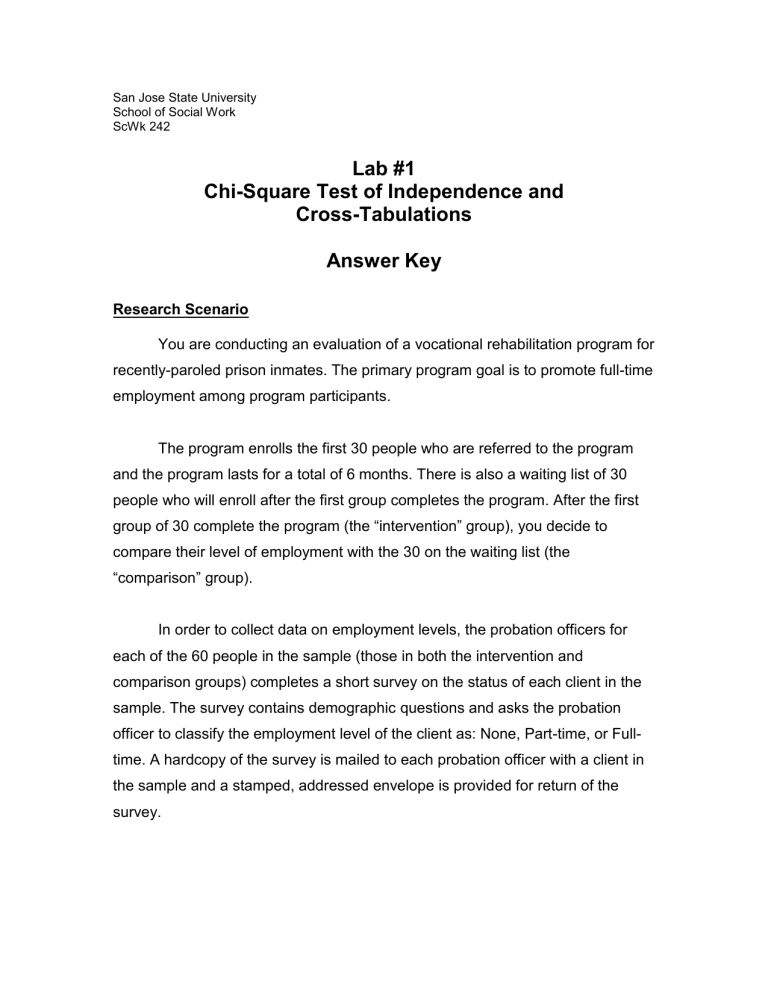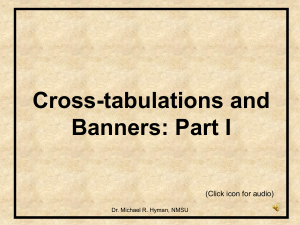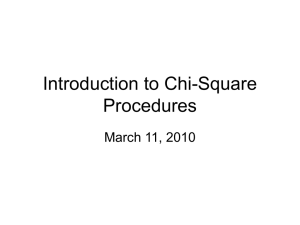Lab #1 Chi-Square Test of Independence and Cross-Tabulations

San Jose State University
School of Social Work
ScWk 242
Lab #1
Chi-Square Test of Independence and
Cross-Tabulations
Answer Key
Research Scenario
You are conducting an evaluation of a vocational rehabilitation program for recently-paroled prison inmates. The primary program goal is to promote full-time employment among program participants.
The program enrolls the first 30 people who are referred to the program and the program lasts for a total of 6 months. There is also a waiting list of 30 people who will enroll after the first group completes the program. After the first group of 30 complete the program (the “intervention” group), you decide to compare their level of employment with the 30 on the waiting list (the
“comparison” group).
In order to collect data on employment levels, the probation officers for each of the 60 people in the sample (those in both the intervention and comparison groups) completes a short survey on the status of each client in the sample. The survey contains demographic questions and asks the probation officer to classify the employment level of the client as: None, Part-time, or Fulltime. A hardcopy of the survey is mailed to each probation officer with a client in the sample and a stamped, addressed envelope is provided for return of the survey.
Using an 8-Step Process for Hypothesis Testing
Once you have your output, use the 8-step process for hypothesis testing to describe and interpret your findings. Please refer to the research scenario and your SPSS output to answer the questions.
1) Identify the independent variable and the level of measurement
The independent variable is the vocational rehabilitation program and the level of measurement is categorical/nominal (2 categories: intervention group or comparison group).
2) Identify the dependent variable and the level of measurement
The dependent variable is employment, and the level of measurement is categorical/ordinal (3 categories: None, Part-time or Full-time).
3) State the null hypothesis
There is no relationship between participation in the vocational rehabilitation program and employment (could also say something like, there is no impact, no effect etc…).
4) State the alternative hypothesis
There is a relationship between participation in the vocational rehabilitation program and employment (there is an impact, an effect etc….).
5) Identify appropriate statistical test and alpha level
The appropriate statistical test is the chi-square because both the independent and the dependent variables are categorical
The alpha level is set at .05 (expressed as:
= .05)
6) Present table of results (SPSS output)
Program.Participation
* Employment
N
Case Processing Summary
Valid
59
Percent
98.3%
N
Cases
Missing
Percent
1 1.7%
N
60
Total
Percent
100.0%
Program.Participation
Total
Program.Participation * Employment Crosstabulation
Intervention Group
Comparison Group
Count
% within Program.
Participation
Count
% within Program.
Participation
Count
% within Program.
Participation
None
5
Employment
Part-Time Full-Time
7 18
16.7% 23.3% 60.0%
16
55.2%
21
35.6%
7
24.1%
14
23.7%
6
20.7%
24
40.7%
Chi-Square Te sts
Pearson Chi-S quare
Lik elihood Ratio
Value
11.748
a
12.321
df
2
2
As ymp. Sig.
(2-sided)
.003
.002
Linear-by-Linear
As soc iation
N of V alid Cases
11.548
1
59 a.
0 c ells (.0% ) have expected count less than 5. The minimum expected count is 6.88.
.001
Total
30
100.0%
29
100.0%
59
100.0%
7) Describe results and decision to accept or reject the null hypothesis
When reporting results for the Chi-Square test, you will report 4 things:
1) The degrees of freedom
2) The sample size
3) The ChiSquare test statistic: This is the “Pearson Chi-Square”
4)
The p value: This is the “Asymp. Sig (2-sided)”
This is APA format for reporting Chi-Square results:
X 2 = (2, N = 59) =11.748, p < .003**,
Since the p value of less than .003 is less than the alpha of .05, we will reject the null hypothesis and conclude that there is a relationship between participation in the vocational rehabilitation program and employment.
***Remember that the p value can never actually be “0.” SPSS rounds the p value to three decimal points, so the p value is actually something less than ,
.001. This is typically expressed as p < .001.
8) Provide a discussion of these results.
Include:
Statistical significance
Summary of the direction of the relationship
Meaning and implications of the results
Limitations/areas for future research
Results of the Chi-Square test indicated a statistically significant relationship between participation in the vocational rehabilitation program and employment outcomes among recently paroled inmates. Specifically, a higher rate of full-time employment was found within the intervention group:
60.0%(n=18) of participants in the intervention group were employed full-time after 6 months of participation in the program, compared to 20.7% (n=6) of participants who were on the waiting-list and did not participate in the program.
These results indicate that the vocational rehabilitation program may be effective at promoting full-time employment among recently paroled inmates.
However, there are limitations to this study; because no random assignment was used, it is possible that differences between the groups were due to pre-existing differences among the participants (e.g. selection bias).
Future studies should include a matched comparison group or, if possible, a control group. In addition, future studies should assess not only whether or not a recently paroled individual obtains employment, but also the degree to which they are able to maintain their employment, earn a living wage, and satisfy conditions of their probation.




